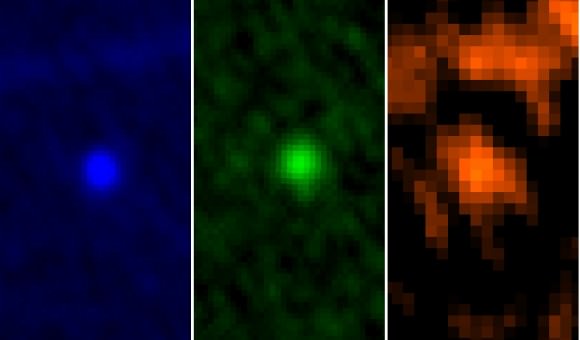During its close approach this week, observatories from ESA and NASA have made some updates on their assessment of asteroid Apophis and its future encounters with Earth. While the Herschel Space Telescope observations indicates the asteroid is bigger and less reflective than first estimated, scientists at the Jet Propulsion Laboratory have effectively ruled out the possibility that this asteroid will impact Earth during a close flyby in 2036.
Repeat after me: Asteroid Apophis is not a threat to Earth in 2029 or 2036. Got that doomsday prognosticators?
Discovered in 2004, Apophis garnered lots of attention when initial calculations of its orbit indicated a 2.7 percent possibility of an Earth impact during a close flyby in 2029. Data discovered during a search of old astronomical images provided the additional information required to rule out the 2029 impact scenario, but a remote possibility of one in 2036 remained – until now.

Herschel provided the first thermal infrared observations of Apophis at different wavelengths, which together with optical measurements helped refine estimates of the asteroid’s properties. Previous estimates bracketed the asteroid’s average diameter at 270 ± 60 m; the new Herschel observations returned a more precise diameter of 325 ± 15 m.
“The 20% increase in diameter, from 270 to 325 m, translates into a 75% increase in our estimates of the asteroid’s volume or mass,” says Thomas Müller of the Max Planck Institute for Extraterrestrial Physics in Garching, Germany, who is leading the analysis of the new data.
By analyzing the heat emitted by Apophis, Herschel also provided a new estimate of the asteroid’s albedo – a measure of its reflectivity – of 0.23. This value means that 23% of the sunlight falling onto the asteroid is reflected; the rest is absorbed and heats up the asteroid. The previous albedo estimate for Apophis was 0.33.
Knowing the thermal properties of an asteroid indicates how its orbit might be altered due to subtle heating by the Sun. Known as the Yarkovsky effect, the heating and cooling cycle of a small body as it rotates and as its distance from the Sun changes can instigate long-term changes to the asteroid’s orbit.
Additional data from the Magdalena Ridge Observatory in New Mexico, the Pan-STARRS observatory in Hawaii and the Goldstone Solar System Radar have provided more conclusive evidence when scientists ran the numbers.
“We have effectively ruled out the possibility of an Earth impact by Apophis in 2036,” said Don Yeomans, manager of NASA’s Near-Earth Object Program Office at JPL. “The impact odds as they stand now are less than one in a million, which makes us comfortable saying we can effectively rule out an Earth impact in 2036. Our interest in asteroid Apophis will essentially be for its scientific interest for the foreseeable future.”
But the flyby on April 13, 2029 will be one for the record books, scientists say. On that date, Apophis will become the closest flyby of an asteroid of its size when it comes no closer than 31,300 kilometers (19,400 miles) above Earth’s surface.
“But much sooner, a closer approach by a lesser-known asteroid is going to occur in the middle of next month when a 40-meter-sized asteroid, 2012 DA14, flies safely past Earth’s surface at about 17,200 miles,” said Yeomans. “With new telescopes coming online, the upgrade of existing telescopes and the continued refinement of our orbital determination process, there’s never a dull moment working on near-Earth objects.”
Goldstone radar observations of Apophis will continue through January 17th, and additional tracking is planned next month with the Arecibo radio dish in Puerto Rico, which should provide even more refinements in Apophis’ orbit.
(99942) Lead video: APOPHIS sur fond d’étoiles au Pic du Midi from Francois Colas on Vimeo.


For those interrested a reminder of a previous UT story:
http://www.universetoday.com/38384/asteroid-impact-calculator/
.
note: As an old Roman saying goes: “If it doesn’t kill you, it will make you a youtube hit”.
surface area of Earth is 510,072,000 km² in case you want to know the odds that you’ll be close enough to make a youtube vid. 60km distance on a 300m high building might do.
I’m guessing on time scales of 1000s of years it is going to eventually hit the earth. So at some time in the future we are going to have to deal with it.
Whewy! I am SOOO glad we landed a radar transponder on that chunk of icy rock! What’s that you say? Twas naught done? Off with his head!
I just wish they’d given either the real time duration of the video or simply told us how fast it’s currently moving. I am, for reasons beyond me, interested in this tidbit. Oh well, off to Google I go!
We should capture this when it comes in 2029 and use it as the orbiting weight to attach the rest of a space elevator to on Earth.